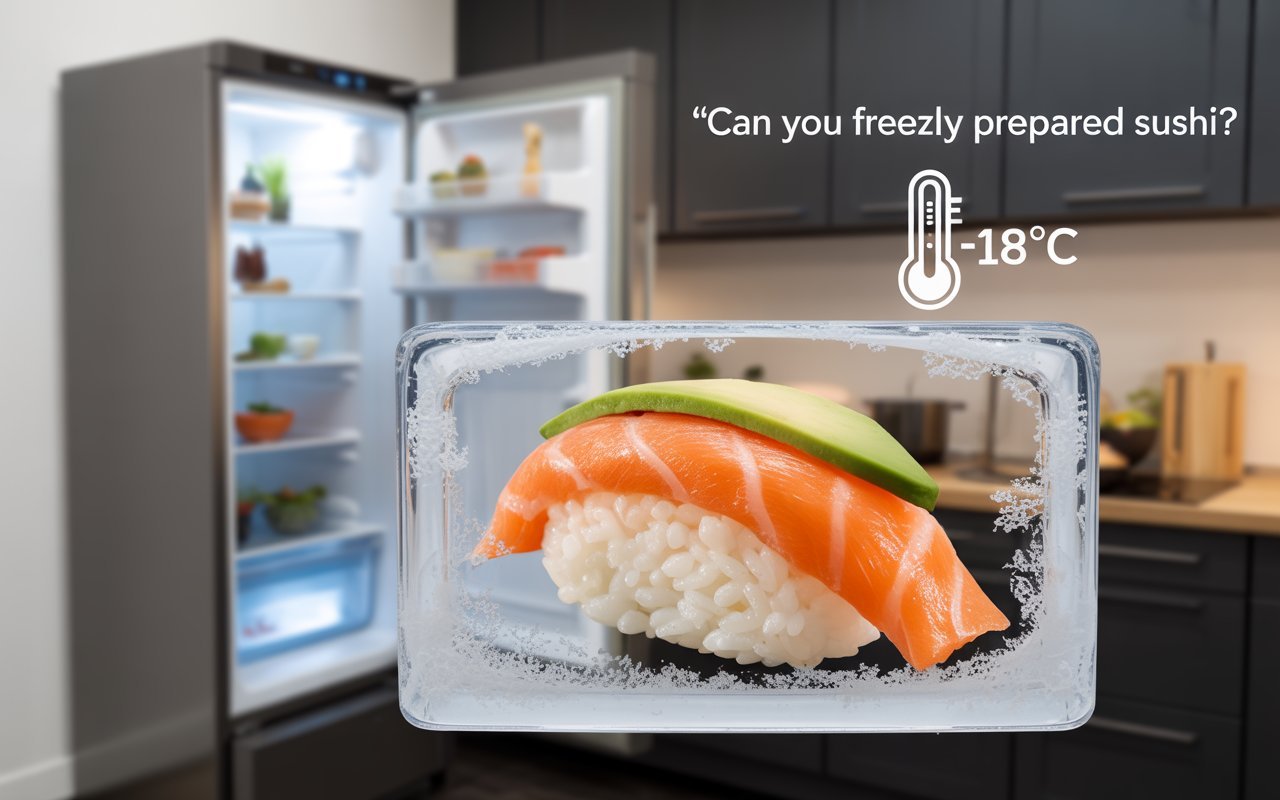The Best Fluffy Pancakes recipe you will fall in love with. Full of tips and tricks to help you make the best pancakes.


Have you ever wondered how long Sushi will be kept in the fridge? Sushi is a delicious and famous Japanese dish enjoyed worldwide, but it is also very delicate due to its inclusion of raw fish and other perishable ingredients. These components can spoil quickly if not stored correctly. Improper storage of Japanese dishes can lead to food spoilage, loss of freshness, and even food poisoning or stomach upset caused by harmful bacteria.
This complete guide will answer your queries about the shelf life of sushi and safe storage practices. You will learn how to tell if this Japanese dish has gone bad, how to refrigerate Sushi properly, and tips to extend its freshness. Whether you have leftover Japanese dish from a restaurant or store-bought rolls, this article will help you enjoy your Sushi safely while minimising waste. Keep reading to discover everything about this Japanese dish, including freshness, safety guidelines, and storage timelines.
Why Sushi Shelf Life Matters
Sushi tastes best when it is fresh. Eating spoiled food can cause serious health risks, such as food poisoning. Since it contains raw fish, it can carry bacteria and parasites if not taken or stored correctly. Understanding the shelf life of this Japanese dish helps you keep your food safe and delicious.
Understanding the Risks of Improper Sushi Storage
When it is stored incorrectly, harmful bacteria like Salmonella, Listeria, or Vibrio can proliferate. These bacteria cause foodborne illnesses characterised by symptoms such as nausea, vomiting, stomach pain, and diarrhoea. To avoid this, this Japanese dish should be kept at the right temperature and eaten within safe time limits.
Types and Their Shelf Lives
Different types of this Japanese dish last different times in the fridge. Here is a quick guide:
Raw Fish (Nigiri, Sashimi)
Raw fish is the most sensitive. It should be eaten within 24 hours of refrigeration. After this, bacteria proliferate, and it can be unsafe.
Cooked Fish (Eel, Crab)
Cooked it lasts a bit longer — up to 48 hours if stored properly in the fridge.
Vegetarian (Avocado Rolls, Cucumber Rolls)
Vegetarian. This Japanese dish lasts the longest. It can stay untouched in the fridge for up to 3 days.
Store-Bought Sushi vs. Restaurant
- Store-bought Sushi often has a “use by” date. Typically, it remains fresh for 2-3 days when stored in the refrigerator.
- Restaurant sushi is best eaten on the same day. Leftovers should be eaten within 24 hours.
Factors Affecting Sushi Shelf Life
Several factors affect how long this Japanese dish stays fresh:
- Ingredients Used: Raw fish spoils faster than cooked fish or vegetables.
- Type of Rice and Seasoning: Rice contains vinegar, which helps preserve it, but cannot stop spoilage.
- Temperature Control: must be stored at a temperature below 40°F (4°C).
- Time Since Preparation: The longer it sits at room temperature, the faster it spoils.
- Packaging Method: Airtight packaging helps keep this Japanese dish fresh by minimising exposure to air and moisture.
Keep untouched at Room Temperature for up to 4 Hours
This Japanese dish should not be left out at room temperature for more than 4 hours. After that, bacteria proliferate, and it can become unsafe to eat. If you want to eat later, put it in the fridge as soon as possible.
Can You Store it in the Refrigerator?
Yes, this Japanese dish can be safely stored in the refrigerator if kept cold and in an airtight container. Refrigeration slows bacteria growth and keeps food fresh longer.
Can You Eat Fresh Sushi the Following Day?
You can eat a popular dish the next day if it is refrigerated right after preparation or purchase. Before eating, check if it smells fresh and looks normal.
How Do You Know If Sushi Is Still Good?
- Smell: A Fresh dish has a mild, clean scent. A sour or fishy smell means spoilage.
- Appearance: Fish should be shiny and moist, not slimy or dull.
- Texture: Rice should be soft, not dry or stiff.
- If the dish looks or smells bad, do not eat it.
How Can You Tell If Sushi Has Gone Bad?
- It smells sour or rotten.
- Fish feels slimy or sticky.
- Rice is hard, dry, or crumbly.
- You see mould or discolouration.
Can You Freeze Freshly Prepared Sushi?
Freezing. This Japanese dish is not recommended because it changes the texture and flavor, especially of the rice and raw fish. If you must freeze this Japanese dish, wrap it tightly and consume it within one month after thawing in the refrigerator.
Proper Storage Methods
Ideal Refrigerator Temperature
Store in the refrigerator at 40°F (4°C) or below to slow bacterial growth.
Best Containers and Packaging Tips
Use airtight containers or wrap tightly in plastic wrap before keeping it in the refrigerator.
Placement in Fridge: Where to Store It Safely
Store on the middle or bottom shelves where the temperature is steady. Avoid the fridge door, as it tends to be more generous than the rest of the fridge.
How to Tell If Sushi Has Gone Bad
- Smell: A sour, fishy, or rotten smell means the Sushi is bad.
- Texture and Appearance: Slimy fish, dry or hard rice, or mould means the Sushi has spoiled.
- Signs of Bacterial Growth: Unusual colours or spots are warning signs.
- Taste Warning Signs: If it tastes sour or off, spit it out immediately.
Storage Timelines (At-a-Glance)
Japanese dish Type Refrigerator Storage Time
Raw for up to 24 hours
Cooked for Up to 48 hours
Vegetarian for Up to 3 days
Store-bought lasts 2 to 3 days
Frozen Up to 1 month (not ideal)
Freezing Sushi – Can You & Should You?
Freezing. This Japanese dish is not ideal because it changes the texture and taste. Freeze only if necessary, and eat quickly after thawing in the fridge.
Health Risks of Eating Spoiled Sushi
Eating spoiled food can cause food poisoning due to the presence of toxic bacteria, such as Salmonella or Listeria. Symptoms include stomach cramps, vomiting, diarrhoea, and nausea. If symptoms are severe or last more than 24 hours, seek medical help.
How to Maximise Sushi Freshness
- Refrigerate immediately after purchase or preparation.
- Use sour elements, such as vinegar and lemon juice, to help preserve freshness.
- Store ingredients separately when possible.
- Use ice packs when transporting.
Cultural Insights and Sushi Traditions
Traditionally, in Japan, this Japanese dish was preserved through fermentation and salt rather than being eaten fresh as it is today. Freshness is positively appreciated in Japanese civilization, as it demonstrates respect for both ingredients and customers.
Summary: Key Takeaways
- Always store it below 40°F (4°C).
- Keeping refrigerated at or below 40°F (4°C) slows the growth of harmful bacteria, helping to keep your dish safe and fresh for a longer period.
- Do not leave it at room temperature for more than 4 hours.
- Bacteria proliferate at room temperature, so they should not be left out longer than 4 hours to avoid food poisoning risks.
- Raw fish sushi should be eaten within 24 hours.
- Raw fish, such as nigiri or sashimi, is highly perishable and should be consumed within 24 hours of proper refrigeration.
Final Sushi Lifespan Guidelines
- Eat fresh. This Japanese dish is best eaten the same day, whenever possible.
- For the best taste and safety, enjoy Sushi on the day it is made or purchased.
- Store leftovers properly in airtight containers and follow the recommended safe storage times.
- Keep leftover refrigerated in airtight containers immediately. Eat raw fish sushi within 24 hours and cook vegetarian Sushi within 2 to 3 days. Constantly scrutinise leftovers before eating.
- When in doubt, throw it out.
- If you are unsure about the freshness or safety, it is safer to discard it than risk food poisoning.
Frequently Asked Questions (FAQs)
Can I eat Sushi the next day?
Yes, if it was refrigerated immediately and shows no signs of spoilage.
Only cooked or vegetarian Sushi, if stored properly and still fresh.
Can you eat sushi rice after 2 days?
It may be safe, but it usually becomes dry and less tasty.








